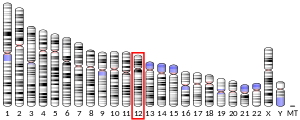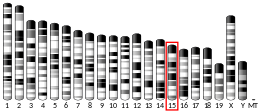Integrin alpha 5
Integrin alpha-5 is a protein that in humans is encoded by the ITGA5 gene.[5]
The product of this gene belongs to the integrin alpha chain family. Integrins are heterodimeric integral membrane proteins composed of an alpha chain and a beta chain. This gene encodes the integrin alpha 5 chain. Alpha chain 5 undergoes post-translational cleavage in the extracellular domain to yield disulfide-linked light and heavy chains that join with beta 1 to form a fibronectin receptor. In addition to adhesion, integrins are known to participate in cell-surface mediated signalling.[6]
Interactions
See also
References
- 1 2 3 GRCh38: Ensembl release 89: ENSG00000161638 - Ensembl, May 2017
- 1 2 3 GRCm38: Ensembl release 89: ENSMUSG00000000555 - Ensembl, May 2017
- ↑ "Human PubMed Reference:".
- ↑ "Mouse PubMed Reference:".
- ↑ Sosnoski DM, Emanuel BS, Hawkins AL, van Tuinen P, Ledbetter DH, Nussbaum RL, Kaos FT, Schwartz E, Phillips D, Bennett JS, et al. (Aug 1988). "Chromosomal localization of the genes for the vitronectin and fibronectin receptors alpha subunits and for platelet glycoproteins IIb and IIIa". J Clin Invest. 81 (6): 1993–8. doi:10.1172/JCI113548. PMC 442653. PMID 2454952.
- ↑ "Entrez Gene: ITGA5 integrin, alpha 5 (fibronectin receptor, alpha polypeptide)".
- ↑ Tani, T T; Mercurio A M (Sep 2001). "PDZ interaction sites in integrin alpha subunits. T14853, TIP/GIPC binds to a type I recognition sequence in alpha 6A/alpha 5 and a novel sequence in alpha 6B". J. Biol. Chem. United States. 276 (39): 36535–42. doi:10.1074/jbc.M105785200. ISSN 0021-9258. PMID 11479315.
Further reading
- Ruoslahti E (1996). "Integrin signaling and matrix assembly". Tumour Biol. 17 (2): 117–24. doi:10.1159/000217975. PMID 8658014.
- Coulombel L, Auffray I, Gaugler MH, Rosemblatt M (1997). "Expression and function of integrins on hematopoietic progenitor cells". Acta Haematol. 97 (1–2): 13–21. doi:10.1159/000203655. PMID 8980606.
- Porter JC, Hogg N (1999). "Integrins take partners: cross-talk between integrins and other membrane receptors". Trends Cell Biol. 8 (10): 390–6. doi:10.1016/S0962-8924(98)01344-0. PMID 9789327.
- Evans JP (2001). "Fertilin beta and other ADAMs as integrin ligands: insights into cell adhesion and fertilization". BioEssays. 23 (7): 628–39. doi:10.1002/bies.1088. PMID 11462216.
External links
- CD49e+Antigen at the US National Library of Medicine Medical Subject Headings (MeSH)
- ITGA5 Info with links in the Cell Migration Gateway
This article is issued from
Wikipedia.
The text is licensed under Creative Commons - Attribution - Sharealike.
Additional terms may apply for the media files.




